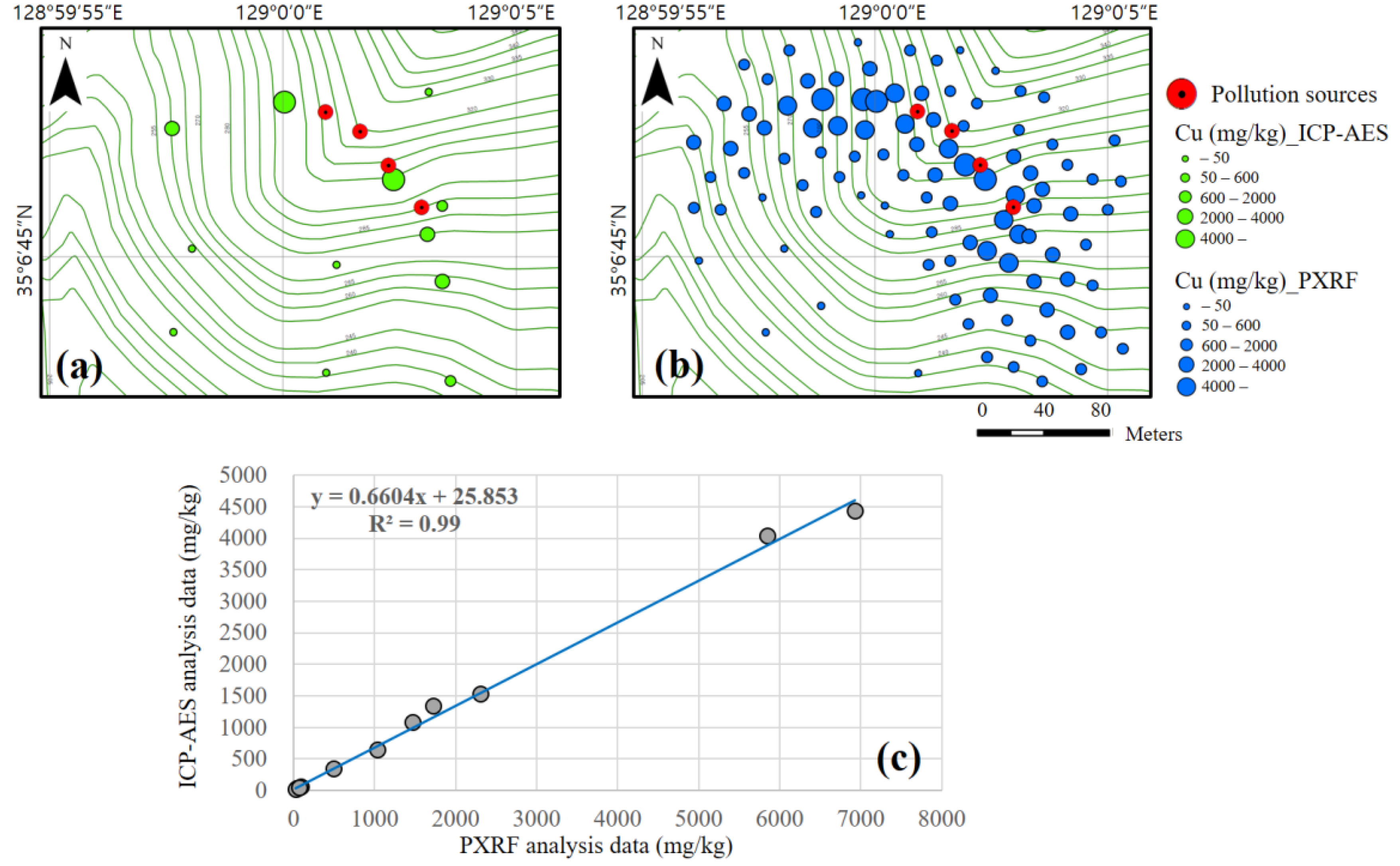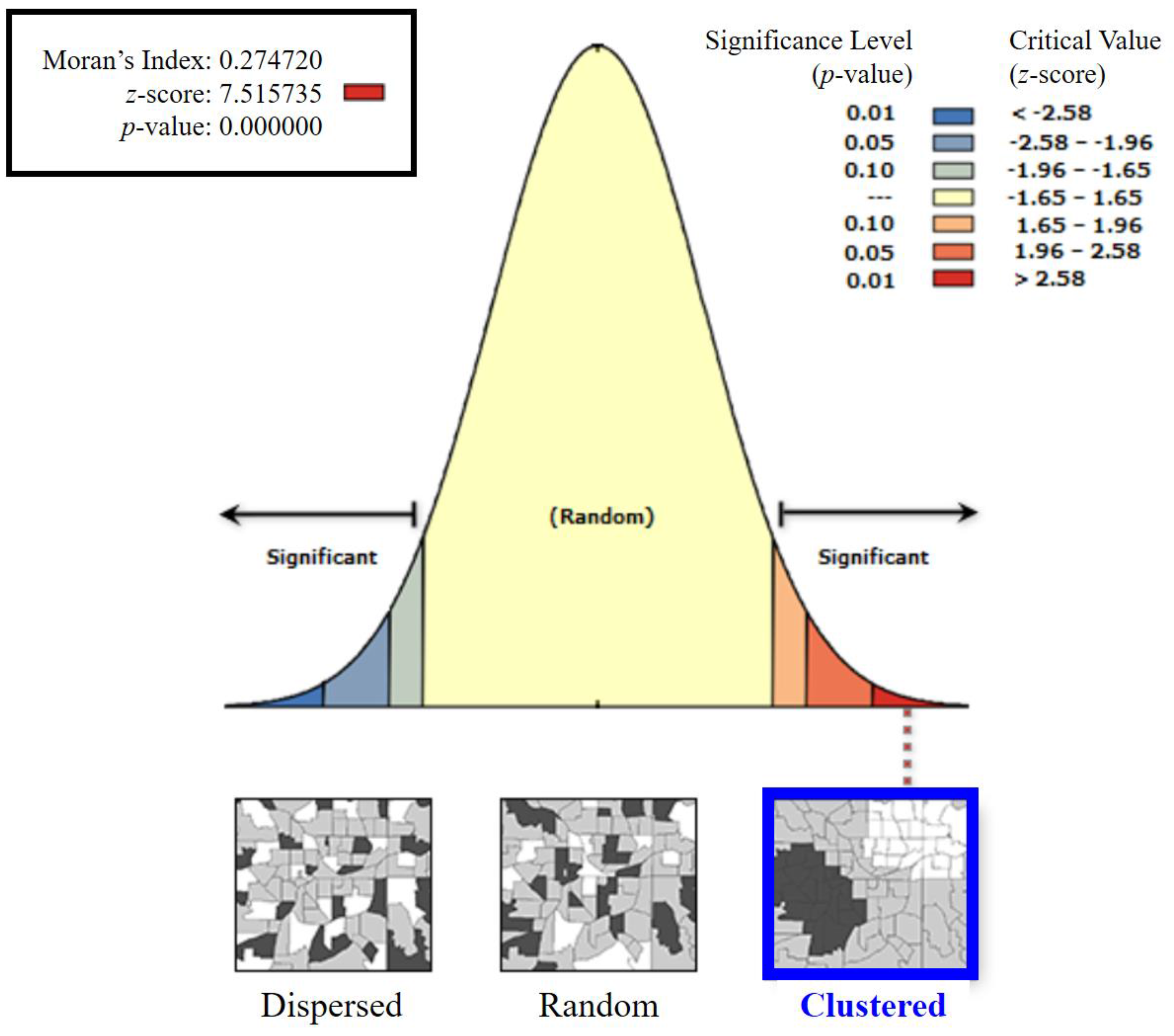Assessing Statistically Significant Heavy-Metal Concentrations in Abandoned Mine Areas via Hot Spot Analysis of Portable XRF Data
Abstract
:1. Introduction
2. Materials and Methods
2.1. Study Area and Soil Sampling
2.2. Hot Spot Analysis
2.3. Methods of Applying Hot Spot Analysis to Copper-Concentration Sampling and Assessment
3. Results and Discussion
3.1. Soil Sampling Results
3.2. Spatial Autocorrelation Results
3.3. PXRF Analysis and Classification
4. Conclusions
Acknowledgments
Author Contributions
Conflicts of Interest
Abbreviations
| PXRF | Portable X-ray fluorescence |
| ICP–AES | Inductively coupled plasma atomic emission spectrometry |
| PTEs | Potentially toxic trace elements |
| GIS | Geographic information systems |
| HH | A high concentration value with a high z-score |
| LH | A low concentration value with a high z-score |
| LL | A low concentration value with a low z-score |
| HL | A high concentration value with a low z-score |
References
- Kim, S.M.; Choi, Y.; Suh, J.; Oh, S.; Park, H.D.; Yoon, S.H.; Go, W.R. ArcMine: A GIS extension to supportmine reclamation planning. Comput. Geosci. 2012, 46, 84–95. [Google Scholar] [CrossRef]
- Lee, H.; Choi, Y.; Suh, J.; Lee, S.H. Mapping copper and lead concentrations at abandoned mine areas using element analysis data from ICP-AES and portable XRF instruments: A comparative study. Int. J. Environ. Res. Public Health. 2016, 13, 384–398. [Google Scholar]
- Waziri, N.M. Environmental geochemistry of soils and stream sediments from the Birnin-Gwari Artisanal gold mining area, north-western Nigeria. Univers. J. Geosci. 2014, 2, 18–27. [Google Scholar]
- Wahsha, M.; Al-Rshaidat, M.M. Potentially Harmful Elements in Abandoned Mine Waste. In PHEs, Environment and Human Health; Bini, C., Bech, J., Eds.; Springer: Dordrecht, The Netherlands, 2014; pp. 199–220. ISBN 978-94-017-8964-6. [Google Scholar]
- Kim, S.M.; Choi, Y.; Suh, J.; Oh, S.; Park, H.D.; Yoon, S.H. Estimation of soil erosion and sediment yield from mine tailing dumps using GIS: A case study at the Samgwang mine, Korea. Geosyst. Eng. 2012, 15, 2–9. [Google Scholar] [CrossRef]
- Lee, H.; Choi, Y. A Study on the soil contamination maps using the handheld XRF and GIS in abandoned mining areas. J. Korean Assoc. Geogr. Inf. Stud. 2014, 17, 195–206. [Google Scholar]
- Steiger, B.; Webster, R.; Schulin, R.; Lehmann, R. Mapping heavy metals in polluted soil by disjunctive kriging. Environ. Pollut. 1996, 94, 205–215. [Google Scholar] [CrossRef]
- White, J.G.; Welch, R.M.; Norvell, W.A. Soil zinc map of USA using geostatistics and geographic information systems. Soil Sci. Soc. Am. J. 1997, 61, 185–194. [Google Scholar] [CrossRef]
- Li, X.; Lee, S.; Wong, S.; Shi, W.; Thornton, I. The study of metal contamination in urban soils of Hong Kong using a GIS-based approach. Environ. Pollut. 2004, 129, 113–124. [Google Scholar] [CrossRef] [PubMed]
- Liu, X.M.; Xu, J.M.; Zhang, M.K.; Huang, J.H.; Shi, J.C.; Yu, X.F. Application of geostatistics and GIS technique to characterize spatial variabilities of bioavailable micronutrients in paddy soils. Environ. Geol. 2004, 46, 189–194. [Google Scholar] [CrossRef]
- Mahmoudabadi, E.; Sarmadian, F.; Savaghebi, G.H.; Alijani, Z. Accuracy assessment of geostatistical methods for zoning of heavy metals in soils of urban-industrial areas. Int. Res. J. Appl. Basic. Sci. 2012, 3, 991–999. [Google Scholar]
- Kim, S.M.; Choi, Y.; Yi, H.; Park, H.D. Geostatistical prediction of heavy metal concentrations in stream sediments considering the stream networks. Environ. Earth. Sci. 2017, 76, 72–89. [Google Scholar] [CrossRef]
- Buttafuoco, G.; Tallarico, A.; Falcone, G.; Guagliardi, I. A geostatistical approach for mapping and uncertainty assessment of geogenic radon gas in soil in an area of Southern Italy. Environ. Earth. Sci. 2010, 61, 491–505. [Google Scholar] [CrossRef]
- Kalnicky, D.J.; Singhvi, R. Field portable XRF analysis of environmental samples. J. Hazard. Mater. 2001, 83, 93–122. [Google Scholar] [CrossRef]
- Higueras, P.; Oyarzun, R.; Iraizoz, J.M.; Lorenzo, S.; Esbri, J.M.; Martinez-Coronado, A. Low-cost geochemical surveys for environmental studies in developing countries: Testing a field portable XRF instrument under quasi-realistic conditions. J. Geochem. Explor. 2012, 113, 3–12. [Google Scholar] [CrossRef]
- Suh, J.; Lee, H.; Choi, Y. A rapid, accurate, and efficient method to map heavy metal-contaminated soils of abandoned mine sites using converted portable XRF data and GIS. Int. J. Environ. Res. Public Health. 2016, 13, 1191–1208. [Google Scholar] [CrossRef] [PubMed]
- Kitanidis, P.K. Parameter uncertainty in estimation of spatial functions: Bayesian analysis. Water Resour. Res. 1986, 22, 499–507. [Google Scholar] [CrossRef]
- Getis, A.; Ord, J.K. The analysis of spatial association by use of distance statistics. Geogr. Anal. 1992, 24, 189–206. [Google Scholar] [CrossRef]
- Ma, Z.; Zuckerberg, B.; Porter, W.F.; Zhang, L. Use of localized descriptive statistics for exploring the spatial pattern changes of bird species richness at multiple scales. Appl. Geogr. 2012, 32, 185–194. [Google Scholar] [CrossRef]
- Wang, F.; Guo, D.; McLafferty, S. Constructing geographic areas for cancer data analysis: A case study on late-stage breast cancer risk in Illinois. Appl. Geogr. 2012, 35, 1–11. [Google Scholar] [CrossRef] [PubMed]
- Ceccato, V.; Dolmen, L. Crime in rural Sweden. Appl. Geogr. 2011, 31, 119–135. [Google Scholar] [CrossRef]
- Zhang, P.; Wong, D.W.; So, B.K.L.; Lin, H. An exploratory spatial analysis of western medical services in Republican Beijing. Appl. Geogr. 2012, 32, 556–565. [Google Scholar] [CrossRef]
- Leslie, T.F.; Frankenfeld, C.L.; Makara, M.A. The spatial food environment of the DC metropolitan area: Clustering, co-location, and categorical differentiation. Appl. Geogr. 2012, 35, 300–307. [Google Scholar] [CrossRef]
- McClintock, N. Assessing soil lead contamination at multiple scales in Oakland, California: Implications for urban agriculture and environmental justice. Appl. Geogr. 2012, 35, 460–473. [Google Scholar] [CrossRef]
- Griffith, D.A.; Chun, Y.; Lee, M. Locational Error Impacts on Local Spatial Autocorrelation Indices: A Syracuse Soil Sample Pb-Level Data Case Study. In Proceedings of the Spatial Accuracy Assessment in Natural Resources and Environmental Sciences, Montpellier, France, 5–8 July 2016; pp. 136–143. [Google Scholar]
- Ministry of Environment (MOE). Soil Contamination Assessment Report in Abandoned Metallic Mines; Ministry of Environment: Gwachun, Korea, 2007; pp. 973–987.
- Hou, X.; He, Y.; Jones, B.T. Recent advances in portable X-ray fluorescence spectrometry. Appl. Spectrosc. Rev. 2004, 39, 1–25. [Google Scholar] [CrossRef]
- Tolner, M.; Vaszita, E.; Gruiz, K. On-site screening and monitoring of pollution by a field-portable X-ray fluorescence measuring device. In Proceedings of the Consoil 2010 Conference, Salzburg, Austria, 22–24 September 2010. [Google Scholar]
- Ministry of Environment (MOE). Korean Standard Test (KST) Method for Examination of Soil. Resource Document. Available online: http://www.me.go.kr/home/web/policy_data/read.do?menuId=10264&seq=3950 (accessed on 9 March 2017).
- Oh, C.W.; Yu, Y.H.; Lee, P.K.; Park, S.W.; Lee, Y.Y. The controversial points and a remedy on evaluation of heavy metal contamination in standard method for examination of soil in Korea. J. Soil. Groundw. Environ. 2001, 6, 63–83. [Google Scholar]
- Davis, J.C. Statistics and Data Analysis in Geology, 3rd ed.; John Wiley & Sons: New Jersey, NJ, USA, 2002; ISBN 978-0-471-17275-8. [Google Scholar]
- Anselin, L. Spatial Econometrics: Methods and Models; Springer Science & Business Media: New York, NY, USA, 1988; ISBN 978-94-015-7799-1. [Google Scholar]
- Environmental Systems Research Institute (ESRI). ArcGIS Desktop Help 10.2 How Hot Spot Analysis (Getis-Ord Gi*) Works. Available online: http://resources.arcgis.com/en/help/main/10.2/index.html (accessed on 1 April 2017).
- Sacristán, D.; Recatalá, L.; Rossel, R.V. Toxicity and bioaccumulation of Cu in an accumulator crop (Lactuca sativa L.) in different Australian agricultural soils. Sci. Hortic. 2015, 193, 346–352. [Google Scholar] [CrossRef]
- Environmental Systems Research Institute (ESRI). ArcGIS Desktop Help 10.2 Optimized Hot Spot Analysis (Spatial Statistics). Available online: http://resources.arcgis.com/en/help/main/10.2/index.html (accessed on 1 April 2017).
- Song, J.; Choi, Y.; Yoon, S.H. Analysis of photovoltaic potential at abandoned mine promotion districts in Korea. Geosyst. Eng. 2015, 18, 168–172. [Google Scholar] [CrossRef]
- Choi, Y.; Park, H.D.; Sunwoo, C. Flood and gully erosion problems at the Pasir open pit coal mine, Indonesia: A case study of the hydrology using GIS. Bull. Eng. Geol. Environ. 2008, 67, 251–258. [Google Scholar] [CrossRef]
- Choi, Y.; Yi, H.; Park, H.D. A new algorithm for grid-based hydrologic analysis by incorporating stormwater infrastructure. Comput. Geosci. 2011, 37, 1035–1044. [Google Scholar] [CrossRef]
- Choi, Y. A new algorithm to calculate weighted flow-accumulation from a DEM by considering surface and underground stormwater infrastructure. Environ. Modell. Softw. 2012, 30, 81–91. [Google Scholar] [CrossRef]








| No. | Cu (mg/kg) (ICP-AES) | Cu (mg/kg) (PXRF) | Cu (mg/kg) (Transformed PXRF) | Remark |
|---|---|---|---|---|
| 1 | 17 | 29 | 45 | 12 sampling points at which both ICP-AES and PXRF analyses were performed |
| 2 | 29 | 40 | 52 | |
| 3 | 33 | 58 | 64 | |
| 4 | 48 | 78 | 77 | |
| 5 | 57 | 94 | 88 | |
| 6 | 344 | 499 | 355 | |
| 7 | 636 | 1044 | 715 | |
| 8 | 1080 | 1470 | 997 | |
| 9 | 1338 | 1731 | 1169 | |
| 10 | 1535 | 2316 | 1555 | |
| 11 | 4041 | 5853 | 3891 | |
| 12 | 4437 | 6930 | 4602 |
| Item | Phase | The Number of Samples | Minimum | Maximum | Mean | Std. Dev. |
|---|---|---|---|---|---|---|
| Transformed copper concentrations | 1 | 30 | 45 | 4602 | 961.6 | 1121.5 |
| 2 | 50 | 45 | 4602 | 902.8 | 958.0 | |
| 3 | 80 | 40 | 5477 | 895.6 | 1102.2 | |
| 4 | 100 | 40 | 5477 | 771.8 | 1027.4 | |
| Gi* z-score | 1 | 30 | −1.36 | 1.78 | 0.18 | 0.86 |
| 2 | 50 | −2.16 | 3.38 | 0.29 | 1.42 | |
| 3 | 80 | −2.26 | 3.56 | 0.41 | 1.61 | |
| 4 | 100 | −2.05 | 3.76 | 0.50 | 1.73 |
| Sampling Point | Initial Analysis Phase (Phase) | Initial Cu Value (mg/kg) | Initial Classification (Class) | Second Analysis Phase (Phase) | Second Cu Value (mg/kg) | Second Classification (Class) |
|---|---|---|---|---|---|---|
| A | 1 | 1505 | 4 | 2 | 112 | 3 |
| B | 3 | 1320 | 4 | 4 | 1333 | 4 |
| C | 3 | 353 | 2 | 4 | 1555 | 1 |
| D | 3 | 865 | 2 | 4 | 838 | 1 |
© 2017 by the authors. Licensee MDPI, Basel, Switzerland. This article is an open access article distributed under the terms and conditions of the Creative Commons Attribution (CC BY) license (http://creativecommons.org/licenses/by/4.0/).
Share and Cite
Kim, S.-M.; Choi, Y. Assessing Statistically Significant Heavy-Metal Concentrations in Abandoned Mine Areas via Hot Spot Analysis of Portable XRF Data. Int. J. Environ. Res. Public Health 2017, 14, 654. https://doi.org/10.3390/ijerph14060654
Kim S-M, Choi Y. Assessing Statistically Significant Heavy-Metal Concentrations in Abandoned Mine Areas via Hot Spot Analysis of Portable XRF Data. International Journal of Environmental Research and Public Health. 2017; 14(6):654. https://doi.org/10.3390/ijerph14060654
Chicago/Turabian StyleKim, Sung-Min, and Yosoon Choi. 2017. "Assessing Statistically Significant Heavy-Metal Concentrations in Abandoned Mine Areas via Hot Spot Analysis of Portable XRF Data" International Journal of Environmental Research and Public Health 14, no. 6: 654. https://doi.org/10.3390/ijerph14060654
APA StyleKim, S.-M., & Choi, Y. (2017). Assessing Statistically Significant Heavy-Metal Concentrations in Abandoned Mine Areas via Hot Spot Analysis of Portable XRF Data. International Journal of Environmental Research and Public Health, 14(6), 654. https://doi.org/10.3390/ijerph14060654







